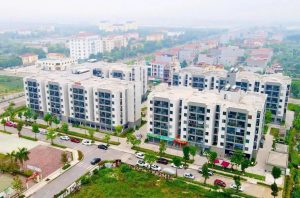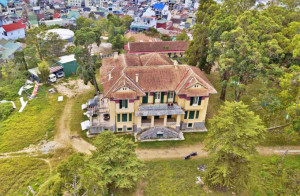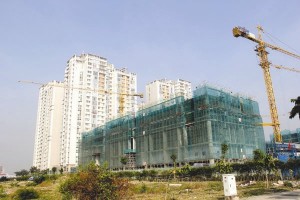Công bố quốc tế trong lĩnh vực kiến trúc, xây dựng (Tuần 4 tháng 10-2021)
Trong số này chúng tôi xin giới thiệu tới quý độc giả những nội dung chính của các công bố quốc tế đăng tải trên ScienceDirect và Springer Nature do Cục Thông tin khoa học và công nghệ quốc gia (NASATI) mua quyền truy cập như sau:
Quy hoạch đô thị:
– Nghiên cứu về hợp tác quản lý tái tạo đô thị dựa trên mạng Bayes: Trường hợp của Trùng Khánh
– Xây dựng cơ sở hạ tầng cho tái tạo toàn diện
– Ứng dụng công nghệ GIS và AHP để xác định các khu vực có cấu trúc không gian và chức năng phát triển hoàn chỉnh, chặt chẽ: Một nghiên cứu điển hình ở Bialystok, Ba Lan
– Không gian hóa dễ dàng với hai trường hợp dựa trên LADM và BIM
– Khung đánh giá năng lực thực hiện đô thị để phát triển trung tâm thương mại lớn. Một nghiên cứu điển hình về 22 quận thành phố của Tehran
– Phân tích các bề mặt nhân tạo mới trong khu vực lưu vực của 12 thị trấn cỡ trung bình của Hungary từ năm 1990 đến năm 2018
– Bài học kinh nghiệm từ quy hoạch sử dụng đất có sự tham gia của người dân với ảnh viễn thám độ phân giải cao ở Tanzania: Góc nhìn của các học viên và người tham gia
– Từ không gian ngầm đô thị (UUS) sang đô thị dưới lòng đất bền vững (SUU): Chuyển trọng tâm trong học thuật ngầm đô thị
– Giá trị của không gian xanh đô thị công cộng: Đo lường tác động của khoảng cách gần và quy mô của không gian xanh đô thị đối với giá trị thị trường nhà ở ở San José, Costa Rica
Khoa học và công nghệ trong lĩnh vực kiến trúc, xây dựng:
– Hệ thống sàn liên hợp thép-bê tông với các cấu hình kết cấu và tải trọng khác nhau theo kịch bản loại bỏ cột góc: Thử nghiệm thực nghiệm
– Kết nối dầm sâu giảm dần cho khung thép nhịp dài
– Thiết kế ứng suất trước cho kết cấu thanh chống cáp bằng cách nhóm các phần tử
– Phương pháp thực nghiệm thay thế để xác định khả năng chống nứt chéo của dầm bê tông cốt thép
– Phát triển chỉ số độ bền cho hệ thống chịu tải song song
– Ứng dụng học sâu để dự đoán phản ứng địa chấn phi tuyến tính của ga tàu điện ngầm
– Nghiên cứu lý thuyết về mô hình chùm tia kép để phát hiện tần số đường ray / cầu và mô-đun đường ray bằng phương tiện di chuyển
– Đánh giá ứng xử địa chấn của màng chắn ngang CLT trên các tòa nhà hỗn hợp với tường chịu cắt bê tông cốt thép
– Khe trượt để kiểm soát phản ứng địa chấn của kết cấu xây bằng đá Ashlar
– Nghiên cứu thực nghiệm, số học và phân tích về hiệu suất địa chấn của bộ giảm chấn khớp nối chịu cắt do uốn
Vật liệu xây dựng:
– Đặc điểm của bê tông siêu nhẹ gốc xi măng xỉ hoạt tính kiềm với cenosphere khối lượng lớn
– Mối quan hệ giữa thành phần và tính chất hydrat hóa-vi cấu trúc-cơ học của hệ bậc ba xi măng-metakaolin-đá vôi
– Khả năng chống axit của vật liệu tổng hợp geopolymer sợi tre, gốc metakaolin
– Thiết kế hỗn hợp tối ưu và dự đoán mô đun đàn hồi của bê tông cường độ cực cao
– Hiệu quả tổng hợp đối với việc kiểm soát ăn mòn bê tông trong môi trường cống rãnh đạt được bằng cách áp dụng rửa bề mặt trên bê tông trộn canxi nitrit
– Hợp kim sắt và thép kết cấu từ thế kỷ XIX cho đến ngày nay: Sự phát triển của tính chất cơ học và đề xuất phương pháp xác định nhanh
– Sử dụng chất thải phá dỡ công trình hoạt hóa kiềm để cải tạo đất cát với các thí nghiệm quy mô lớn trong phòng thí nghiệm
– Các đặc tính thay đổi theo thời gian của độ bền và ứng xử chịu lực bên của cọc bê tông cốt thép thanh FRP trong môi trường biển
– Phương pháp tiếp cận máy học kết hợp trong dự đoán và định lượng độ không đảm bảo của cường độ nén cuối cùng của cột RCFST
– Khả năng chịu nén dọc trục của cột bê tông được gia cố bằng cốt thép lai chống ăn mòn
– Máy học trong thiết kế hỗn hợp bê tông nhẹ Miscanthus
Xin trân trọng giới thiệu!
QUY HOẠCH ĐÔ THỊ
- Research on the collaborative governance of urban regeneration based on a Bayesian network: The case of Chongqing
Land Use Policy, Volume 109, October 2021, 105640
Abstract
The rapid development of the economy and urbanization has led to numerous urban regeneration projects, and collaborative governance is increasingly advocated to address the management issues that occur during urban regeneration. However, strong collaboration is still a great challenge among multiple stakeholders during the process of urban regeneration. Based on Bayesian network theory and the case of Chongqing, this article aims to deconstruct the complex structure and explore the inherent mechanism of urban regeneration governance to achieve collaboration. First, a Bayesian network model of urban regeneration governance was developed to visualize the complex structure of multiple stakeholders’ interests. Second, the inherent mechanism was analyzed though Bayesian inference. The results indicate that the cooperation degree of related governments, conflict resolution efficiency, degree of public participation, and normality of public participation may be key factors that lead to collaborative behavior. Third, a further discussion was conducted, based on which policy implications were drawn to promote collaborative governance in urban regeneration.
- Building infrastructures for inclusive regeneration
Land Use Policy, Volume 109, October 2021, 105606
Abstract
This paper explores the foundational role of physical infrastructure in making inclusive, community-led regeneration possible. It does this through documenting three years of engaged research on participatory planning, conducted in Westfield, a community in Sheffield, UK, which experiences ‘multiple deprivation’. The research looked to support community-led planning efforts taking place under the auspices of the Big Local regeneration programme and afforded significant insight into the combined impacts of austerity and ideologically driven community development initiatives for people trying to make positive change in their communities. Our principal contributions are twofold: firstly, a theoretical contribution, on the role of physical infrastructure and how it is understood in making certain kinds of community development possible and impossible; secondly, the application of this theoretical insight to a concrete case, Westfield’s pub-turned-community-centre, Com.unity. We conclude by arguing for the critical importance of ‘the publicness of public things’, and the need for a fundamental reimagining of the roles and responsibilities of both the state and communities in valuing and investing in the infrastructures that make inclusive urban regeneration possible .
- Easement spatialization with two cases based on LADM and BIM
Land Use Policy, Volume 109, October 2021, 105641
Abstract
An easement is an important usufructuary right, and its main purpose is that one party wants to use the property of others to improve the benefits and interests of his own real estate. Because of the increasing population and accelerating urbanization urban planners have focused on the development and utilization of three-dimensional urban space, namely, underground, near ground and aboveground space, to use the spatial resources fully. Therefore, jurisprudence-confined planar easement must be combined with spatial information from two dimensions (2D) to three dimensions (3D), as well as 2D property boundaries to be extended to 3D to adapt to urban development. This paper focuses on the easement of access, which is the right to cross the property to go to and from another, under the context of 3D cadastres. The model of easement spatialization based on BIM (Building Information Model) specified by IFC (Industry Foundation Class) standards is constructed and analysed. The servient owner and the dominant owner of the easement can be linked because they are both attached to the same physical space. This paper takes a multistory building having individually owned condominium units as an example to demonstrate how to access the semantic information associated with the geometric information of 3D property objects in the BIM/IFC. The research results show that BIM/IFC can optimize the complex presentation of 3D property attributes and is an effective carrier of easement spatialization. The combination of legal information and spatial information of 3D properties not only optimizes the operation and maintenance of buildings but also improves land management and accelerates the development of 3D cities.
- Application of gis technology and AHP to determine the areas with fully developed, compact functional and spatial structure: A case study of Bialystok, Poland
Land Use Policy, Volume 109, October 2021, 105616
Abstract
The main objective of this study is to develop a method of identifying compact urban areas, which are characterized by a fully developed functional and spatial structure. Identification of such areas is a necessary element in studying the conditions and directions of spatial development in Poland. Moreover, the analysis of a development’s compactness and the availability of basic functions is a part of the model of urban policy promoting the concept of the compact city: well known in the world and only now being implemented in Poland. This paper uses GIS technology and the Analytic Hierarchy Process (AHP) to propose a set of measurable criteria for the compactness of urban structures. Spatial analyses were performed considering the accessibility of selected objects and functions, the result of which is a series of maps presenting the categorization of the study area in terms of the level of development of a compact functional and spatial structure.
- Urban carrying capacity assessment framework for mega mall development. A case study of Tehran’s 22 municipal districts
Land Use Policy, Volume 109, October 2021, 105628
Abstract
This paper presents the research results on the evaluation of Tehran’s 22 municipal districts’ carrying capacity concerning mega malls. Here, we developed an Urban Carrying Capacity Assessment Framework (UCCAF). Using a combination of objective and subjective methods, we determined the final weights of economic, social, environmental, and transportation criteria and their 25 subsequent indices. For the objective weights, we used the “Ekbatan Mega Mall” as a case study and entered the data from field observation, interviews, and questionnaires into the Rapid Impact Assessment Matrix (RIAM). Next, we distributed the criteria and indices to the experts to collect their views and priorities. To obtain subjective weights from these priorities, we used a Multi-Criteria Decision Making (MCDM) method, i.e., Step-wise Weight Assessment Ratio Analysis (SWARA). Next, we applied Weighted Aggregated Sum Product Assessment (WASPAS) to combine the final weights of indices with the UCCAF results. Here, the districts’ ultimate rankings concerning their carrying capacity for mega malls were obtained. Finally, using the cluster analysis method, districts were classified into six clusters of optimum (district 22), good (district 5), acceptable (districts 21, 4, and 2), poor (districts 19 and 20), very poor (the rest of districts except district 12), and critical (district 12) in terms of carrying capacity. The results reveal that 21 out of 36 recently-built mega malls of Tehran are located in districts with very poor carrying capacity. The proposed framework provides urban planners with a dynamic carrying-capacity-based decision support system.
- Clustering the built form at LAU2 level for addressing sustainable policies: Insights from the Belgium case study
Land Use Policy, Volume 109, October 2021, 105642
Abstract
Population growth has determined two different types of urban development: the vertical growth, tending to compactness, and the horizontal one which privileges a more dispersed and sprawled expansion. Those two urban forms have different impacts on environmental sustainability influencing, among others, the microclimate conditions of a city, the energy demand and its economic cost, and the provision of Ecosystem Services. European policies are oriented towards sustainable development of urban areas reducing the environmental footprint and restoring degraded ecosystem through a Green infrastructure deployment. Understanding the urban form, and specifically, the typology of the building form is crucial for policymakers and urban planners to define strategies for a higher degree of sustainability. The lack of data and the heterogeneity of information across Europe on the built form have hindered the operationalisation of European strategies and their downscaling into national or regional policies. The paper aims to fill this gap proposing a methodology based on a cluster analysis that estimates the built form of Belgium at LAU2 level for addressing single specific actions towards environmental sustainability goals. The cluster analysis uses data traditionally surveyed by national censuses, ensuring the replicability of the method for the upcoming 2021 census, and also the opportunity to update it continuously.
- Studentification and governance in South Africa: Dependencies and conflicts
Land Use Policy, Volume 109, October 2021, 105639
Abstract
The term ‘studentification’ is used to describe the socio-spatial implications of students occupying housing in the suburbs near the universities. Our paper looks at how studentification is managed in South Africa, where rising student numbers have caused conflict with other residents. We show that despite a history of segregation and low densities in South African cities, policymakers seldom consider the role that studentification plays in desegregation and in creating higher densities but focus instead on its negative impacts and how to regulate it. Hidden interests and a rigid planning framework focusing on control are underlying to this response. On the one hand, the planners need to take the concerns from existing landowners seriously. On the other hand, planners’ embeddedness in the history of planning as a tool to control as opposed to a more facilitating role is central to an understanding of the situation. We use evolutionary governance theory to show that this focus is mostly the result of path dependencies, goal dependencies and conflicts associated with interdependencies. The focus on norms and standards largely ignores the fact that about 70% of the students at the University of the Free State, the site of our case study, live in unregulated accommodation. We recommend that policymakers should consider alternatives such as pro-active upzoning and using rates and taxes as a way to bring about change.
- Analyses of new artificial surfaces in the catchment area of 12 Hungarian middle-sized towns between 1990 and 2018
Land Use Policy, Volume 109, October 2021, 105644
Abstract
Although several research studies have been published on post-socialist urban development in Hungary and also in the Central European region from various aspects and in different time frames, an overview about the different categories of new artificial land uses in the case of second-tier towns has not appeared yet. Based on the Corine Land Cover Inventory, Land Use Changes (CLC CHA) database (1990–2018), this paper is to fill this gap by analysing 12 Hungarian Functional Urban Areas (FUA). The first results highlight the importance of structural changes and regional differences of Hungarian urban sprawl, and also identify reasons for the different development patterns and clusters. The study presents the regions affected by the emerging artificial surfaces. It shows the later industrialisation of eastern towns, the intensive growth of urban living areas between 1990 and 2006, the dominance of motorway constructions and the marginal role of new urban green areas in the urban sprawl. The impact of post-socialist policy and regulation (protection, land use plans, housing policy) and of EU funds is also discussed.
- Lessons learned from participatory land use planning with high-resolution remote sensing images in Tanzania: Practitioners’ and participants’ perspectives
Land Use Policy, Volume 109, October 2021, 105649
Abstract
Participatory mapping (PM) solutions have become common in many sectors of society to enhance engagement of the local communities in planning processes. Especially in data scarce regions, like Africa, PM that captures local knowledge in spatially explicit form is an important tool for integrating previously non-existent spatial knowledge in to collaborative planning. Despite the increasing usage of PM solutions, there still lies a gap in our knowledge of the influence and enabling factors of PM adoption in real-world decision-making processes. We studied practitioners’ and participants’ perceptions on benefits and limitations of PM that uses high-resolution remote sensing imagery to engage with participants in six use cases in Tanzania. We conducted interviews and one group discussion with practitioners, and feedback surveys among PM participants. According to the experiences of the practitioners and participants, PM methods based on high-resolution remote sensing images have increased practitioners’ work quality and professional competence, and enhanced participants’ active participation and spatial understanding for informed decision-making. Technical challenges and lack of skilled experts and institutional support were commonly identified limitations. Based on the users’ perceptions we identified previously recognized enabling factors such as supportive policy environment but also context specific factors; removal of disincentives and wider awareness raising. Moreover, advocacy among policymakers on the benefits of participatory decision-making and geospatial technologies is needed to build their ownership of the new governance practices.
- From urban underground space (UUS) to sustainable underground urbanism (SUU): Shifting the focus in urban underground scholarship
Land Use Policy, Volume 109, October 2021, 105650
Abstract
This viewpoint argues that for sustainable urban development the relationship between the city and the ground beneath it needs increased attention. The underground volume might provide additional urban space, but it cannot be treated in the same way as above-ground space. Cross-disciplinary research and professional collaboration are needed to better understand (a) the variety of processes at play, and (b) the role of geotechnical engineers and geoscientists in working towards sustainable underground urbanism.
- Mitigating “displaced” land degradation and the risk of spillover through the decommoditization of land products
Land Use Policy, Volume 109, October 2021, 105659
Abstract
Land degradation impacts human well-being and biodiversity while increasing exposure to emerging infectious diseases. The primary indirect driver of land degradation is consumption, which increasingly involves agricultural products produced far away. Reversing these negative trends requires the decommoditization of land products through consumer-transparent “farm to table” information on land health combined with an efficient land use planning that is a greater optimization of land use and management decisions towards the achievement of multiple benefits.
- The value of public urban green spaces: Measuring the effects of proximity to and size of urban green spaces on housing market values in San José, Costa Rica
Land Use Policy, Volume 109, October 2021, 105656
Abstract
Urban green spaces increase population wellbeing because they provide for recreational possibilities, as well as with many other benefits that are not related with direct use, like air purification, landscape aesthetics, or flood control. The objective of this paper is to estimate the effect of proximity to and size of urban green spaces on housing market values. We implement a hedonic price model to test the effect of distance from and size of three types of urban green spaces in San Jose, Costa Rica: i. non-developed natural areas, ii. metropolitan parks, and iii. neighborhood parks. The results show that individuals assign substantial value to the restoration of non-developed green areas, proximity to large urban green spaces, and size of neighborhood parks. We also found that urban green spaces correlate with those values declared by house owners only, i.e., not by house renters. The results for non-developed natural areas are the opposite of those from developed countries. This paper can help to inform urban planning policies, by giving insights of the effect of urban green spaces in the value of capital assets and human wellbeing. Additionally, we administer our own socioeconomic survey to gather original data on house market prices in developing countries, due to the lack of such data. The paper contributes to the literature by showing the relevance of conducting site-specific studies, and by offering a methodological approach to close the gap in information available on developing countries.
- Are small towns really inefficient? A data envelopment analysis of sampled towns in Jiangsu province, China
Land Use Policy, Volume 109, October 2021, 105590
Abstract
Small towns, the nodes connecting cities and villages, play an important role in urbanization and rural development. However, it is generally believed that small towns lack economic efficiency therefore are excluded from main-stream urbanization of China. Based on the socio-economic statistics of 109 towns in 7 counties of Jiangsu province, this paper evaluates the DEA efficiency of small towns with different classifications, and compares the DEA efficiency of small towns with 21 county-towns, then analyzes the economic density of small towns and 283 prefecture-level cities with different scales. The results show that: (1) There are significant differences in the efficiency characteristics of different types of towns. Approximately 80% of the sampled towns could improve their efficiency by intensive resource-use and production scale expansion; (2) Although county-towns obtained more resources, their efficiency is not significantly superior than other types of towns (P > 0.05); (3) Small towns perform well in terms of economic density, which is not significantly different from small and medium-sized cities, but significantly lower than large cities with population of municipal district > 1 million. These findings challenge the stereotypes of towns in driving urbanization. The authors argue that the economic development level, input-output efficiency and economic density of small towns can also be high, shaping their important role in integrating urban and rural development, accelerating new-type urbanization and promoting rural vitalization strategy.
- From a cluster of villages to a city: Housing politics and the dilemmas of spatial planning in Tamale, Ghana
Land Use Policy, Volume 109, October 2021, 105668
Abstract
This paper examines the growth trajectories of the city of Tamale, Ghana, using secondary data and archival material. It profiles the colonial planning experiences in the city and the way in which planning practices influenced collective actions in the pro-poor housing sector. The analyses show that at its founding in the early part of the 20th century, Tamale had a considerably large proportion of indigenous population whose housing practices fell beyond the scope of formal housing and planning regulations. Thus, moving people for purposes of redeveloping old indigenous housing clusters was the defining feature of colonial urban planning practices in the city. It is argued in this paper that the fragmented planning strategy adopted for the colonial city created an agglomeration of suburbs with poorly articulated spatial connectivity and a pattern of development which could not be easily predicted nor managed. To date, this pattern of spatial development continues to structure the housing politics in low-income sections of the city and offer part explanation to why housing demolitions have become fully entrenched in post-independent urban development programmes. The paper makes significant contributions by clarifying the exact mechanism through which colonial planning decisions were inscribed on the emergent city and the ways in which the attendant socioeconomic and spatial transformation processes have served to exclude the poor from the city space.
- Why municipalities grow: The influence of fiscal incentives on municipal land policies in Germany and the Netherlands
Land Use Policy, Volume 109, October 2021, 105681
Abstract
It is generally assumed that municipalities attract residents and businesses as a result of intermunicipal competition for tax revenues. This growth-oriented behaviour poses a serious problem considering internationally acknowledged goals to limit land take. Nonetheless, research on how fiscal incentives affect municipal land policies is scarce. Adapting a neoinstitutionalist approach, we compare the two contrasting fiscal systems of Germany and the Netherlands. While clear incentives can be deducted from the different sources of municipal income, complex balancing measurements and consequential infrastructure investments make it difficult to predict a project’s profitability. According to the perspective of planning practitioners in municipalities around the growth centres of Utrecht and Berlin interviewed for this study, local pressures force them to keep allocating new building sites. In order to create effective policies to limit land take, it is important to understand not only the influence of fiscal incentives but also of place-specific pressures on municipal land policies.
- Types of planning systems and effects on construction material volumes: An explanatory analysis in Europe
Land Use Policy, Volume 109, October 2021, 105682
Abstract
The management of material stock is central for reducing emissions and for optimizing natural resource use. Construction materials are particularly the key because of their role in emission, resource use, and waste management concerns. However, the role of governance and spatial planning in the management of construction minerals is unclear. Based on a panel dataset of 35 European countries for 1995–2017, this study assesses the effect of governance and spatial planning factors, as well as of core socio-economic indicators (namely, GDP per capita, urbanization, and economic structure) at the national level According to the results, the types of spatial governance and planning systems significantly shape the effects on construction material use. Such effects range from − 67–215% relative to the most widespread system, i.e., the conformative system. Economic structure and urbanization have a positive feedback effect on the accumulation process at any level of development. In addition, the ability to resist excess material accumulation encoded by urbanization and economic transition is determined by spatial governance and planning systems. Additionally, a specific planning culture employing a moderate amount of construction material compared to other spatial governance and planning systems, i.e., the neo-performative system, is identified as a promising means to reduce significantly resource demand both in market- and state-led planning contexts.
- Analysis of spatio-temporal dynamics of urban sprawl and growth pattern using geospatial technologies and landscape metrics in Bahir Dar, Northwest Ethiopia
Land Use Policy, Volume 109, October 2021, 105676
Abstract
This study tried to assess and monitor the spatiotemporal dynamics of urban sprawl and its growth pattern in Bahir Dar, Northwest Ethiopia for the last three and half decades (1984 – 2019). Supervised maximum likelihood technique has been used to map the land use land cover of Bahir Dar from 1984 to 2019 using Landsat TM and OLI datasets. Post classification comparison, spatial landscape metrics, and Shannon’s entropy index were used to detect changes in land use land cover, investigate the complex spatiotemporal dynamics and degree of urban sprawl. Findings of this study indicated that in the study periods, the built-up area increased at the expanse of cropland and forest. The values of Shannon’s entropy index were scaled from 0.45 to 0.74 between 1984 and 2019. Spatial metrics analysis was also computed using CA (261–2566), NP (371 – 3576), PD (1.74 – 9.72), LPI (12−52), ED (7.09 – 46.77) and FRAC-AM (1.12 – 1.25); indicated the existence of sprawl with high dispersion and heterogeneity which gradually expanded from central business district (CBD) to the periphery. The rapid urban expansion which in turn results in urban sprawl has various socio-economic and environmental consequences if sustainable urban planning and management policies are not properly prepared and utilized. The study can enable to devise proper policies and strategies for effective utilization of resources and allocation of infrastructure by controlling improper enforcement of land use.
- Investigating application of compact urban form in central Indian cities
Land Use Policy, Volume 109, October 2021, 105694
Abstract
Background
Developed countries adopt a compact city urban form or the densification policy for sustainable development. However, the conditions differ in the context of developing and developed countries. India has high-density planning and there exists scarce research on the applicability of compact city urban form for sustainable development.
Method
This study assesses the population density in central Indian urban areas. It divides the city into various segments and compares them with the prescribed density range (as per Indian standards). Further, it conducts a spatial assessment of facilities in the segments; and conducts a public opinion survey (480 respondents) to compare living environment and quality of life in each segment.
Results
It shows that density levels within the city vary considerably. Some NHs show scope for densification while some don’t. Therefore, a densification policy will have limited applications. Spatial assessment of facilities shows a lack of facilities in the outskirts. Public opinion reveals a good living environment and quality of life in most of the areas having access to facilities.
Conclusions
The results confirm that a uniform policy related to density cannot be applied to NHs in organically formed Indian cities. It confirms that an optimum density can result in better access to facilities. It also confirms no ill effects of high-density living in central Indian residents. Furthermore, this paper discusses the policy implications using the results of the study. This study can be a starting point for the formulation of density policies and SDG 11 goals for the sustainable Indian neighbourhoods.
KHOA HỌC VÀ CÔNG NGHỆ TRONG LĨNH VỰC KIẾN TRÚC, XÂY DỰNG
- Steel-concrete composite floor systems with different structural and loading configurations under a corner column removal scenario: Experimental tests
Engineering Structures, Volume 244, 1 October 2021, 112736
Abstract
In this study, quasi-static tests were performed on three 3D steel–concrete composite floor systems under a column removal scenario with two variables, i.e., secondary beam connection type and pre-existing axial loads on columns. The work focused on the behavior of the three composite floor systems, including the load–deflection response, failure mode, load-resisting mechanism, e.g., flexure, catenary action and tensile membrane action (TMA), and load redistribution. It was found that secondary beam connection had a pronounced effect on the load–deflection response. Pre-existing axial loads on columns significantly influenced the load redistribution process and intensified the stresses in adjacent columns connected by the secondary beam to the removed column. For all the three specimens, a peripheral compressive ring with TMA was not observed in the composite slab due to a lack of rotational restraint from the perimeter beams and the main girder. However, at large deformation stage, when the composite slab deformed into an approximate hyperbolic-parabolic surface, the entire reinforcing mesh in the slab was in tension. It was observed that, at the early stage, the applied load was mainly resisted by flexure in the slab and the main composite girder and the secondary composite beam connecting to the removed column. But at large deformation stage, part of the applied load was resisted by flexure in the partially damaged slab and the main girder, and the intact secondary beam. Other load-carrying contributions came from catenary action in the main girder and TMA in the slab. In the end, most of the applied loads were redistributed to the columns adjacent to the removed column.
2. Buckling and post-buckling behaviour of selected cold-formed C-beams with atypical flanges
Volume 244, 1 October 2021, 112693, Engineering Structures
Abstract
The paper deals with cold-formed C-beams the cross-section of which is modified when compared to a classical one. The reason of the modification was to increase the stiffness of the beam as well as to increase its buckling and limit load. Different shapes of flanges were proposed in order to investigate their influence on the buckling load, buckling shape and the limit load of the beam. The main investigation was performed with the use of the finite element method thanks to which the models of beams with different cross-sections and of different thickness and length could be taken into account. Linear and non-linear numerical calculations were conducted. Additionally the beams with selected cross-sections have been manufactured and investigated experimentally. The results obtained this way serve as a reference point for the numerical results.
Based on the results obtained from numerical investigation it can be seen that the modification of the flange may increase the buckling and limit load of the beam significantly. Moreover, the analysis of these values reveals that after the loss of stability the beam may bear the load which is larger than the buckling load up to 50% before the limit load is reached. The discrapencies between the results of FE analyses and the experimental data are acceptable and are discussed in the manuscript. Some indications for further investigations are provided.
- Tapered reduced deep beam connection for long span steel moment frames
Engineering Structures, Volume 244, 1 October 2021, 112731
Abstract
Beam to column connection ductility and beam flexural stiffness are crucial parameters for seismic performance and drift control in moment-resisting frames. However, an increase in beam span and depth to obtain column-free flexible internal space affects these parameters negatively. In this paper, a new long-span deep beam-column connection detail is proposed with improved stiffness and adequate ductility for moment frames in low-to-moderate seismic zones. As panel zones can undergo plastic deformation beyond the joint rotation demand in low-to-moderate seismic zones, the beam flange and panel zone in the proposed connection are proportioned such that a stable yielding occurs in the panel zone and two plastic zones on the beam segment away from the beam-column interface. The beam flanges at the beam-column interface are thickened, widened, and tapered to control beam plastic hinge locations and mitigate distress resulting from significant panel zone plastic deformation. The performance of the proposed connection was evaluated through a full-scale cyclic load test and parametric finite element analysis on a beam-column connection with a 1200 mm deep beam. The test and finite element results showed the formation of plastic hinges at the anticipated locations. Furthermore, the connection exhibited stable hysteresis beyond the minimum rotation limits specified for intermediate moment frames (American code) and ductility class medium (Eurocode). Moreover, the connection effectively allowed balancing between beam and panel zone yielding while hindering beam flange distress associated with significant panel zone plastic deformation. Furthermore, a comparison between the proposed and welded unreinforced flange-welded web connection demonstrated improved ductility, stiffness, moment capacity, and energy dissipation capacity. Additionally, equations were proposed to quantify the improvements, and balance beam and panel zone energy dissipation.
- Prestress design for cable-strut structures by grouping elements
Engineering Structures, Volume 244, 1 October 2021, 112010
Abstract
Cable-strut structures, composed of cables in tension and struts in compression, are famous in space and civil engineering. The systems bear the external load and exhibit stiffness only when prestressed, so it is paramount to determine the prestress distribution. This paper presents a novel method to obtain the distribution of initial prestress in cable-strut structures with a given shape and topology. Singular value decomposition is first performed on the equilibrium matrix to obtain the independent self-stress modes. We group the structure by symmetry and decompose a second time to get the number of independent self-stress modes when the number of independent self-stress modes is larger than one. Finally, calculated prestress, expressed by the modes, should also conform to the prescribed member types and stability conditions. This new method shows excellent performance in several examples with different configurations and constraints.
- Development of nonlinear framework for simulation of Typhoon-induced buffeting response of Long-span bridges using Volterra series
Engineering Structures, Volume 244, 1 October 2021, 112721
Abstract
This paper presents a nonlinear time-domain analysis framework to simulate the buffeting response of long-span bridges subjected to the typhoon winds. The analysis framework separates the aerodynamic forces generated on the bridge deck into low- and high-frequency components modelled by the quasi-steady and Volterra series-based wind load models, respectively. The aerodynamic nonlinearity and non-stationary wind effects existing in the wind-bridge interaction are incorporated in the analysis framework in terms of the ① static force coefficients measured at low-frequency effective angle of attack, ② flutter derivatives identified at varying angles of attack, ③ higher order fluid memory terms of the Volterra series and ④ time-varying mean wind speed. The efficacy of the proposed framework is verified by presenting the numerical example of a suspension bridge fully immersed in the typhoon winds with aerodynamic characteristics sensitive to the effective angle of attack. The dynamic analysis results show good agreement in the simulation of the typhoon-induced buffeting response of the bridge deck. Moreover, the simulation results are also compared with the measurements, and the existing linear and nonlinear wind load models to elucidate the efficiency of the proposed framework.
- An alternative experimental methodology to determine the diagonal cracking resistance of steel-reinforced concrete beams
Engineering Structures, Volume 244, 1 October 2021, 112741
Abstract
An alternative experimental method for predicting the diagonal shear cracking resistance of steel-reinforced concrete beams is developed in this paper. Conventional extensometric strain-gauge rosettes are placed on the lateral surfaces of a set of four beams. As diagonal cracking propagates through the beams, the load–strain curves flatten out at a plateau and the mechanical property under consideration may be determined. The method is applied to four beams cast from pumpable and self-compacting concrete mixes with cement types I and IV containing electric arc furnace slag aggregates. The feasibility of applying standard design code formulas to the concretes containing these aggregates may therefore be studied and compared with other recent research works. Accurate experimental results were obtained with this method without having to interrupt the test for subjective visual appraisals of the test specimen.
- Developing a robustness index for parallel load-bearing systems
Engineering Structures, Volume 244, 1 October 2021, 112742
Abstract
The target of this study is to develop a robustness index for parallel load-bearing systems. Parallel load-bearing systems are structural systems with load-bearing elements that are similar in type and function and constitute alternative load paths. For this purpose, a conceptual model is considered. The robustness index will be calculated based on the “stress increase ratio” of the critical cable in a cable-loss scenario. For finding the stress increase ratio of the critical cable, the differential equations of the system have been used. Accordingly, the stress increase ratio of the critical cable has been calculated by deriving an approximation function. In order to maximize the accuracy of the approximation function, the least squares method (LSM) has been used. Then, a reserve-based robustness index for a parallel load-bearing system has been derived. The proposed robustness index considers different levels of the initial damage and can be expanded to account for the initial failure of several load-bearing elements. The developed robustness index has been checked by numerical models and its good accuracy has been proven.
- Deep learning for nonlinear seismic responses prediction of subway station
Engineering Structures, Volume 244, 1 October 2021, 112735
Abstract
A novel and computationally inexpensive method for predicting the nonlinear seismic response of subway stations using deep learning approaches is developed to reduce the computational cost in stochastic seismic responses analysis. The proposed method takes the deformation of the free field where the subway station is located as the input to predict seismic responses of the subway station according to the characteristic of seismic responses of underground structures. One-dimensional convolutional neural network (1D-CNN) and long-short term memory (LSTM) network are adopted for seismic responses modeling of a two-story and three-span subway station in a data-driven fashion as opposed to the computational expensive physics-based finite element model. The prediction performance and extrapolating ability of both models are evaluated and compared with a baseline multi-layer perceptron (MLP) model. With the same training samples, the 1D-CNN has better prediction performance and extrapolating ability than both LSTM and the baseline MLP model and the LSTM model has the worst performance among the three models. The good prediction performance of 1D-CNN makes it suitable to be applied in the stochastic seismic responses analysis using the probability density evolution method (PDEM) which is solved by the finite-difference method (FDM). The evolution characteristics of the probability density function of the layer drift and the distribution characteristics of the peak value of layer drift can be captured by a low computational cost with the proposed method.
- Damage analysis of aluminum alloy gusset joints under cyclic loading based on continuum damage mechanics
Engineering Structures, Volume 244, 1 October 2021, 112729
Abstract
Owing to their advantageous properties, such as light weight, high strength, and good corrosion resistance, aluminum alloys have been widely used for structures in environments subject to corrosion, such as coastal environments and swimming pools. However, compared to steel, aluminum alloys have a lower elastic modulus and thus are more flexible and sensitive to cyclic loads, such as wind loads, and low cycle fatigue failure due to damage accumulation. In this study, we performed hysteretic experiments and low-cycle fatigue experiments to investigate the damage characteristics, including the failure modes, hysteretic curves, and fatigue life, of aluminum alloy gusset joints under cyclic loads. Then, we established a damage-coupled cyclic plastic constitutive model of 6061-T6 aluminum alloy based on continuum damage mechanics and implemented it in ABAQUS through a user-defined material model subroutine (UMAT). The parameters of the constitutive model were determined from cyclic uniaxial tests, and using the subroutine, a numerical simulation of the joints was carried out. The simulation results of the damage distribution, hysteretic curves, and fatigue life of the joints are consistent with the experimental results, which confirm that the analysis method established in this study can predict the crack location effectively. Due to the small number of experimental joints, the prediction of fatigue life needs further research to improve the reliability.
- Noncontact operational modal analysis of light poles by vision-based motion-magnification method
Engineering Structures, Volume 244, 1 October 2021, 112728
Abstract
Light and sign poles on elevated highway bridge are secondary structural elements that support functionality of a highway system. Over the time, they may suffer from fatigue damage due to traffic, wind, and earthquake-induced vibration in a direct or indirect manner. As a secondary structural component, vibrations of light and sign poles are influenced by the bridge vibration, the primary structure. Structural condition assessment of the light and sign poles are normally conducted by visual inspection and/or vibration measurement using contact or noncontact method. In this paper, a vision-based vibration measurement of the light poles on elevated highway bridges using motion magnification and dynamic mode decomposition methods is proposed. Using the method, vibrations of the light poles are captured by video camera and the phase-based motion magnification method is implemented to magnify micro-vibration of the structure. By employing discretized centroid searching method, spatial displacements of the light poles are extracted. Modal parameters of the structure are then identified from the displacement responses by dynamic mode decomposition method. The study includes laboratory experiments for verification, and the full-scale implementation on existing light poles on elevated highway bridges. The vision-based results are compared with the noncontact vibration measurement using Laser-Doppler vibrometers. Results of experiments and full-scale tests demonstrate the capability of the proposed method in extracting multi-mode vibration characteristics of the light poles accurately in a noncontact long-distance measurement.
- Theoretical study on a dual-beam model for detection of track/bridge frequencies and track modulus by a moving vehicle
Engineering Structures, Volume 244, 1 October 2021, 112726
Abstract
A theory is presented for retrieving the track/bridge frequencies and track modulus from an instrumented vehicle moving over a dual-beam model to simulate the track-bridge system. The dual beams are connected by uniform spring-dashpot units to simulate the effects of sleepers and ballast, etc. Based on the dual-beam model, the response of the vehicle is firstly derived in closed form, along with that for the vehicle-track contact point. The dual frequencies solved relate to the track and bridge frequencies. Compared with the vehicle spectrum, the contact-point (CP) spectrum is superior in that it is free of the vehicle and driving frequencies. Using the first “plus” frequency of the dual-beam system, the track modulus can be computed by a simple formula. The proposed technique is numerically validated against the key parameters involved. It is concluded that: (1) the first “plus” frequency can be retrieved from the contact-point spectrum as an outstanding peak; (2) track irregularity has an adverse, but tolerable, effect on retrieval of track modulus; (3) as a trade-off between efficiency and accuracy, the vehicle is suggested to move at a moderate speed; and (4) the proposed technique may be affected by track damping, but remains good for tracks with infinite length.
- Buckling and free vibration of laser-welded web-core sandwich panels: Extreme sensitivity to variation of weld rotational stiffness
Engineering Structures, Volume 244, 1 October 2021, 112737
Abstract
T-joints in laser-welded web-core sandwich panels connect face-plates with web-plates. Rotational stiffness of the T-joints affects transverse shear stiffness of the panels. In this paper we describe the effect of geometric and material parameters on the rotational stiffness of the T-joints, and show that laser weld thickness bears the highest influence. The analysis is performed using detailed FEM models of the joints that include laser welds. The effect is translated to critical buckling and first natural frequency of laser-welded web-core sandwich panels. Structural analyses are performed using equivalent single layer model with the first order shear deformation theory. The models used in this research are validated using experiments and numerical results from literature. The most sensitive and the least sensitive panels to variation of the rotational stiffness are outlined by means of global optimization. We describe them in terms of stiffness coefficients and design variables. The analysis reveals that insensitive panels have small height and small distance between web-plates, and as such have low structural performance for their area density. Panels with the best structural performance are generally quite sensitive to variation of the rotational stiffness, but the sensitivity can be even higher in other panels. It was found that rotational stiffness of T-joints is important in design and optimization of the panels, since the best performing panels of the same area density have different cross-sections for different rotational stiffness.
- Cyclic testing of an innovative self-centering X-braced ductile shear panel
Engineering Structures, Volume 244, 1 October 2021, 112732
Abstract
This paper presents an innovative seismic load-resisting component of braced ductile shear panel (BDSP) with self-centering ability. Tension-only nickel-titanium (NiTi) shape memory alloy (SMA) wires installed along the inclined segments are employed to facilitate the self-centering ability. Thin shear panel with pinching hysteretic feature is adopted to decrease the amount of SMA wires, and it provides sufficient lateral bearing capacity and lateral stiffness. A total of eight specimens at one-third scale tests were performed to investigate the hysteretic behavior and re-centering capacity under cyclic loading. The experimental results show that the adoption of SMA wires inside traditional BDSP component realized the desirable self-centering ability and retained moderate energy dissipation capacity with the equivalent viscous damping ratio in the range of 0.124–0.158. Compared to solid shear panel, the employment of slotted shear panel obtained a considerably pinching hysteretic loop and reduced the amount of SMA wires for providing the re-centering ability. The local buckling and damage were primarily focused on the shear panel. The self-centering BDSP specimens were used as replaceable fuse elements for realizing the repairability after an earthquake. The tension field inclination in the solid shear panel ranged from 18° to 33.5°, which was approximately consistent with the main diagonal direction according to observed experimental phenomenon. Furthermore, the surrounding flanges of shear panel did not play an important role on improving lateral strength. The average overstrength factor of the self-centering BDSP specimens was 1.49.
- Seismic behaviour evaluation of CLT horizontal diaphragms on hybrid buildings with reinforced concrete shear walls
Engineering Structures, Volume 244, 1 October 2021, 112698
Abstract
In the last years in a worldwide level, the number of CLT buildings in height has been increased. In seismic countries, the design of these buildings is limited because there are still discussions about parameters of wood seismic design such as the modification factor of structural response and the allowed story drift. In this context, a hybrid building shaped by a gravity slab system (CLT) and wood columns combined with a seismic-resistant system of reinforced concrete cores, allow the use of wood in high buildings with fewer restrictions than CLT buildings.
Each floor of the hybrid building explained before is composed by a horizontal diaphragm, shaped by CLT panels and connections that provide flexibility to the system. Due to the horizontal diaphragm role in the transfer of seismic loads to the vertical elements, the traditional design expects the diaphragm to behave inside the elastic range. Therefore, the study of the behaviour in a hybrid configuration is taking relevance.
A group of four hybrid buildings with different configurations was submitted to three types of analysis (nonlinear static, spectral modal, time-history), which demonstrate an oscillating seismic behaviour among semi-rigid and flexible. Also, the connections of the models submitted to the time-history analysis were not in the inelastic range, which was justified by the correct choice of the design model. Finally, it was concluded that the correct diaphragm classification is very important because it was demonstrated that increasing the flexibility of the diaphragm increased their demand and decreased the demand on the walls.
- Sliding bed joint for seismic response control of ashlar stone masonry structures
Engineering Structures, Volume 244, 1 October 2021, 112734
Abstract
An isolation technique using sliding bed joint for seismic response control of ashlar stone masonry buildings was developed and investigated in this paper. Eight triplet specimens were tested under cyclic loads to identify suitable interface material for the sliding bed joint. Further, four stone masonry wall specimens were tested to investigate the frictional performance of the sliding bed joint. The sliding friction coefficient of stainless steel plate-stainless steel plate interface was about 0.17 and found to be insensitive to sliding displacement and the level of compressive stress. The proposed interface was found suitable for the sliding bed joint application. Stable frictional performance of sliding bed joint in practical engineering buildings could be achieved by leveling the interface of each group of the discrete distribute steel plates (two pairs of steel plates equidistantly adhesive on one stone block). A two-degrees-of-freedom mathematical model was adopted to investigate the isolation performance of stone structure’s sliding bed joint. No sliding displacement was observed in the isolated stone structures in the case of frequent level earthquake. On the other hand, the average absolute acceleration response in the case of design and rare level earthquakes was significantly reduced compared to fixed base structures. The maximum average sliding displacement of isolated stone structures considered was about 71 mm which is within the half-length of the steel plate. Simple expressions were proposed to predict the average absolute acceleration spectrum of isolated stone structures. The experimental and analytical results provided reference for the application of the sliding bed joint in the stone masonry buildings.
- Experimental investigations on the concrete breakout capacity of crimped sleeves in steel fiber-reinforced concrete
Engineering Structures, Volume 244, 1 October 2021, 112758
Abstract
Crimped sleeves are anchorages suitable for permanent fastening of structural components to reinforced and unreinforced concrete. These consist of a steel sleeve with an internal thread and are crimped at the end to ensure a defined embedment depth in concrete. In this work, experimental investigations were carried out on the tensile and shear behavior of crimped sleeves in steel fiber-reinforced concrete (SFRC). A selection of four crimped sleeves of the same type (M1660, M1680, M2070 and M20100) were tested in normal strength plain concrete and SFRC with 30 kg/m3 and 50 kg/m3 fiber content. The aim was to investigate how these fiber contents contributed to the load-bearing behavior of concrete in tension and shear. In total, 48 crimped sleeves were tested in axial tension and 48 crimped sleeves in shear. The results show, with respect to the embedment depth and diameter, that the steel fibers have a positive effect on the load-deformation behavior of the crimped sleeves. With an improved ductile behavior and the crack bridging by the steel fibers in the SFRC, an optimal utilization of the crimped sleeves can be achieved. A comparison of the present results with further test series from the literature demonstrates that the maximum tensile and shear capacity of concrete can even be increased compared to normal strength concrete.
- Experimental, numerical and analytical study on seismic performance of shear-bending yielding coupling dampers
Engineering Structures, Volume 244, 1 October 2021, 112724
Abstract
A novel yielding damper combining traditional shear and bending yielding devices was proposed and analyzed, in which the bending plates were clamped on both sides of the shear plate to restrain its buckling. Cyclic tests were performed to examine the seismic behavior of the shear–bending yielding coupling (SBYC) dampers. Additionally, finite-element (FE) models were established to investigate the interactive mechanism between the shear and bending plates in detail, particularly in the post-buckling stage. The analysis results revealed that the shear plate exhibited a high buckling mode and that the tensile strips were gradually distributed within the adjacent two bending plates. According to the analysis results, a force–shear angle model was developed for predicting the performance of the SBYC damper, which accounted for both the high mode buckling and stress states of the shear plate in the post-buckling stage. Various parameters, including the height-to-space ratio, gap-to-shear thickness ratio, and thickness of the shear plate, were incorporated into the parametric analyses. The FE results agreed well with the predicted results from the force–shear angle model. The experimental and analytical results provide guidance for the application of the SBYC damper in engineering practice.
VẬT LIỆU XÂY DỰNG
- Characteristics of alkali-activated slag cement-based ultra-lightweight concrete with high-volume cenosphere
Construction and Building Materials, Volume 302, 4 October 2021, 124165
Abstract
In this study, the properties of alkali-activated slag cement (AASC), in which 50, 60, and 70% cenospheres were replaced, were tested and flotation tests were performed by making bricks. Three different cenosphere sizes were used in the experiment. As the cenosphere replacement rate increased, the compressive strength, density, and thermal conductivity values decreased and the water-absorption rate increased. The smaller the cenosphere particle size, the lower was the thermal conductivity and density and the higher was the absorption and compressive strength. Furthermore, the bricks made of 70% cenosphere-substituted mixture floated on the water surface regardless of the size of the cenosphere particles. In AASC with a cenosphere substitution rate exceeding 50%, the size of cenosphere particles greatly affected the physical and mechanical properties. The 70% cenosphere replacement sample was found to be applicable as a floating structural member for marine and freshwater applications.
- Relationship between the composition and hydration-microstructure-mechanical properties of cement-metakaolin-limestone ternary system
Construction and Building Materials, Volume 302, 4 October 2021, 124175
Abstract
This paper aims to elucidate the effect of changes in the mix composition on the properties of Portland cement (PC)-metakaolin (MK)-limestone (LS) ternary system. To achieve this, the mixture proportion was optimized using the simplex design method and its effect on the properties of the binder was evaluated experimentally and correlated via graphical visualization. Experimental results confirmed the enhancement and acceleration of kinetics of cement hydration by LS and MK. However, a higher porosity was noticed at early age and was attributed to the high reactivity of MK which hindered it from acting as an effective filler. Therefore, the correlation between the optimum mix design and compressive strength was found to be dependent on the paste age. The findings of this paper would contribute to a better understanding of the dependence of the properties of PC-MK-LS ternary system on its composition.
- Acid resistance of metakaolin-based, bamboo fiber geopolymer composites
Construction and Building Materials, Volume 302, 4 October 2021, 124194
Abstract
This study focuses on calcined kaolin, commercial sodium silicate, and Amazonian bamboo to make geopolymer. The durability of geopolymer matrix (GP) and bamboo fiber geopolymer composite (GPBF) materials was analyzed by studying the resistance to the exposure to sulfuric and hydrochloric acids at concentrations from 0 to 15 wt%, testing two different geometry of samples. The microstructure of the raw and composite materials was investigated by X-ray fluorescence and scanning electron microscopy. Geopolymer formation was confirmed by X-ray diffraction with a characteristic amorphous hump at 28° two theta and a few crystalline peaks of quartz. Visual appearance, mass change, and compressive strength behavior of all GP and GPBF samples immersed in 0, 5, 15 wt% of H2SO4 and HCl for 7, 28, and 112 days were investigated. GP and GPBF did not change in appearance, and no mass loss was observed in 0% acid (100% water) solution pH 12, an alkali solution due to partial dissolution of NaOH from the GP matrix, denoting durability in water. GP mass loss increased with varying sulfuric acid concentrations from 5, 10, and 15 wt%, resulting in values of 2.7%, 3.5%, and 4.4%, respectively. In general, the GP and GPBF specimens experienced higher compressive strength degradation when exposed to H2SO4 than to HCl. GP and GPBF can safely be applied as construction materials in applications exposed up to 15 wt% sulfuric or hydrochloric acid environments, including in sewage systems.
- Optimised mix design and elastic modulus prediction of ultra-high strength concrete
Construction and Building Materials, Volume 302, 4 October 2021, 124150
Abstract
The use of ultra-high strength concrete (UHSC) could significantly increase the load-carrying capacity of a structural member, and thus reducing the amount of materials used as well as expanding the floor area of buildings due to a reduction in member size. Despite these benefits of UHSC, its practical applications are still limited because of its complicated and uneconomical manufacture. This study therefore investigates different mix designs for UHSC using conventional manufacture methods with commonly used raw materials. An experimental study was also conducted to determine the optimised mix design in terms of the manufacturing cost. Modifications to improve the strength of current UHSC mixes were also suggested. In addition, an empirical equation for predicting the elastic modulus of UHSC was proposed based on an experimental database newly collected from about 300 tests with the cylinder compressive strength in the range from 100 MPa to 200 MPa. By comparing with the equations from current design codes and existing equations, it can be concluded that the proposed equation is not only simple but also gives the best predictions among existing equations.
- Synergistic effect on concrete corrosion control in sewer environment achieved by applying surface washing on calcium nitrite admixed concrete
Construction and Building Materials, Volume 302, 4 October 2021, 124184
Abstract
Microbially influenced concrete corrosion (MICC) is often the major cause for the structure-failure in sewers. To mitigate the MICC, surface washing was considered as a cost efficient approach, however its effect is temporary and limited due to the fast re-establishment of sulfide oxidizing microorganisms (SOMs). Recently calcium nitrite admixed concrete was found as a promising approach to mitigate MICC. In this study, we hypothesize that applying a single surface washing on calcium nitrite admixed concrete would yield synergistic and effective control of MICC in sewers. The corrosion development and re-establishment after high-pressure washing on concrete coupons without calcium nitrite and with 1% (N1) and 4% (N4) (by the weight of cement) of calcium nitrite was investigated by exposing these coupons in a pilot-scale gravity sewer system for sixteen months. The corrosion process was monitored by measuring surface pH, corrosion product composition, corrosion loss and the microbial community. With one wash, the corrosion loss reduced by 45% and 58% in N1 and N4 coupons, respectively. The corrosion mitigation effect of surface washing for coupons without calcium nitrite was negligible. The combined application of surface washing and calcium nitrite admixed concrete showed synergetic effects and promising efficiency in MICC mitigation.
- Thermodynamic model for ternary OPC/CAC/Calcium Sulfate binders
Construction and Building Materials, Volume 302, 4 October 2021, 124120
Abstract
Ternary binders combining Portland (OPC) and calcium aluminate (CAC) cements with calcium sulfate (C) capitalise on differential setting and hardening properties to compensate for expansion or shrinkage.
This study explored hydration over curing times ranging from 1 h to 1 year in nine cements, combinations of OPC, CAC and C prepared with a w/c ratio of 0.4. The experimental findings were subsequently applied to corroborate the results of a thermodynamic model for the same compositions.
According to the model findings, under thermodynamic equilibrium conditions, in binary blends with a high OPC content, the addition of C induces the formation of more ettringite (AFt), but no calcium monosulfoaluminate hydrate (AFm), whereas a higher CAC replacement ratio prompts AFm phase formation and retards OPC hydration. Those two effects were observed to compete in the ternary system, with phase development depending on the initial proportions of the two binders.
A thermodynamic hydration model was developed for the OPC/CAC/C ternary system in keeping with the experimental data and factoring in cement composition, clinker phase hydration kinetics and geochemical speciation-based thermodynamic equilibrium calculations. The model predictions for phase development correlated well with the experimental findings where hydration was assumed to be ongoing in the 1 year materials.
- Iron alloys and structural steels from XIX century until today: Evolution of mechanical properties and proposal of a rapid identification method
Construction and Building Materials, Volume 302, 4 October 2021, 124132
Abstract
Mechanical properties of materials, as provided by current design standards, are the pre-requisites for the proper identification and structural assessment of existing buildings and civil engineering works. For mechanical characterisation, in case of “Limited Knowledge” (KL1) without direct information on the material properties, the usual features according to the standards at the construction time are considered. This is the case, for example, of structural metalworks characterised by historical and artistic interest (bridges, roof galleries, covered markets, railway stations, etc.) or industrial archaeology buildings where, because of the constraints imposed by the National Authorities of Cultural Heritage Preservation, extensive or exhaustive in-situ tests cannot be performed. This paper focuses chronologically, from the XIX century until today, on the evolution process of ferrous alloys, namely cast iron, wrought iron and steel, for structural applications. After a description and classification of the aforementioned materials and their production processes, the main mechanical properties and design stresses for bending and compression elements are briefly analysed and collected in a chronological order. Reference is made to the product specifications and design codes, integrated with data from extensive experimental testing. The resulting database can support realistic assumptions about materials and their properties, used over a range time of over 100 years, once the age of building is known. Finally, a methodology for identifying existing metal carpentry structures, which combines the database with fast non-destructive testing methods, is proposed. Such an approach can be effectively used not only for historical steelworks, but also for the mechanical characterization of structural subsystems or elements (e.g. beams, columns, lintels, tie rods) in common existing buildings made of either steel or steel-rc composite structure.
- CZM analysis and evaluation of influencing factors on interlayer adhesion of asphalt mixture with double-layer continuous pave
Construction and Building Materials, Volume 302, 4 October 2021, 124211
Abstract
The new type of double-layer continuous paving can effectively improve the interlayer adhesion of asphalt mixture and the comprehensive performance of asphalt pavement. However, in the actual process of double-layer continuous paving, the interlayer adhesion of asphalt mixture is affected by many factors (compaction function, construction temperature, process, etc). Therefore, the finite element software (ABAQUS) was used to carry on the three-dimensional modeling of the asphalt pavement, and cohesive zone model (CZM) was used to define the interlayer adhesion of the asphalt mixture to analyze the factors affecting the interlayer adhesion of continuous paving. This paper mainly discusses the influence of different underlayer compaction degree, underlayer compaction temperature, asphalt layer thickness and load action on interlayer bonding and mechanical response. Finally, the grey correlation theory was used to rate the different influencing factors. The results show that when the lower layer is compacted for 50 times, the interlayer adhesion of asphalt pavement is the best, and the ability to resist the displacement crack is the strongest. Increasing the thickness of the upper layer and the compaction temperature of the lower layer of the asphalt pavement can improve the interlayer adhesion and reduce the displacement cracks. At the same time, it is found that the number of precompaction times of lower layer and horizontal braking force are the main factors that affect the interlayer adhesion. The research results have certain theoretical and practical value for the construction technology of double-layer continuous paving of asphalt pavement.
- Utilization of alkali-activated construction demolition waste for sandy soil improvement with large-scale laboratory experiments
Construction and Building Materials, Volume 302, 4 October 2021, 124173
Abstract
Using alkali-activated materials to treat waste materials is becoming more prevalent in geotechnical engineering. Adding these materials into soil particles as a cementitious material can improve the geotechnical properties of problematic soils, and minimize environmental pollution. The present study focused on the feasibility of using alkali-activated construction demolition waste (CDW) as a stabilizer for large-scale soil improvement applications. The CDW was used as a source of aluminosilicate; sodium hydroxide (NaOH), potassium hydroxide (KOH), and calcium oxide (CaO) (at concentrations of 2 M, 6 M, 10 M, and 14 M) were used as the alkaline media. CDW (16%) was selected as the source of alkali-activated material. The optimal concentrations of NaOH, KOH, and CaO were found to be 10 M, 10 M, and 6 M, respectively. Moreover, 21 days and 39 °C yielded the best results at the bearing capacity values. Thus, the use of CDW as an alkali activator is a better remedy for soil engineering properties, and contributes to soil improvement.
- Time-varying characteristics of the durability and lateral bearing behaviour of FRP bar-reinforced concrete piles in marine environments
Construction and Building Materials, Volume 302, 4 October 2021, 124192
Abstract
In this paper, the time-varying characteristics of the durability and lateral bearing behaviour of fibre reinforced polymer (FRP) bar-reinforced concrete piles in marine environments are studied. A diffusion model of chloride ions in FRP bar-reinforced concrete piles is established based on Fick’s second law. The failure probability of the corrosion initiation time of FRP bar-reinforced concrete piles induced by chloride attack is evaluated. The stiffness degradation model of FRP bar-reinforced concrete piles with different replacement ratios of FRP bars is established based on the time-dependent reinforcement corrosion model. The lateral bearing behaviour of FRP bar-reinforced concrete piles under lateral loading is obtained by the finite difference method. The Monte Carlo simulation method is used to generate random parameters to evaluate the failure probabilities of FRP bar-reinforced concrete piles under the failure criteria of bending moment and lateral displacement. The analysis results show that for the same FRP replacement ratio, the bending stiffness of FRP bar-reinforced concrete piles decreases with increasing exposure time, and the decreasing range of bending stiffness of FRP bar-reinforced concrete piles decreases with increasing FRP replacement ratio. For an exposure time of 50 years, the lateral displacement of the pile top increases with an increase in the replacement ratio of the FRP bars but decreases with an increasing replacement ratio of the FRP bars for exposure times of 100 years and 150 years. Before an exposure time of 75 years, the failure probability of FRP bar-reinforced concrete piles under the two failure criteria increases slightly with the increase in the replacement ratio of FRP bars but decreases significantly with the increase in the replacement ratio of FRP bars after an exposure time of 75 years.
- A hybrid machine learning approach in prediction and uncertainty quantification of ultimate compressive strength of RCFST columns
Construction and Building Materials, Volume 302, 4 October 2021, 124208
Abstract
This article introduces a machine learning-based approach to estimate the ultimate compressive strength of rectangular concrete-filled steel tube (RCFST) columns, and to perform an uncertainty quantification of such values. A hybrid model, namely PANN, is built based on artificial neural networks (ANNs) optimized by particle swarm optimization (PSO). The proposed model is based on an experimental data set of 622 cases. The PANN estimation accuracy is benchmarked against four design codes, including EC4, ACI, AISC, and AS. Benchmarked results show that hybrid models are the perfect alternative models to predict the compressive strength of the RCFST column. The RCFST compressive strength depends mainly on geometry, material, and loading configurations which have stochastic features in nature. This study proposes the Monte Carlo technique to investigate stochastic compressive strength behaviors of RCFST columns considering complex interactions of variables with an exposed to inevitable source-uncertainties. Night cases of individual and compound randomness are examined. Convergence studies and sensitivity analyses are performed before uncertainty quantifications on each random parameter are conducted. Systematic consideration of uncertainties in compressive strength may allow for more trust in model results and, if columns are analyzed, designed, it improves the construction’s trustworthiness.
- Effect of steel slag and curing temperature on the improvement in technological properties of biomass bottom ash based alkali-activated materials
Construction and Building Materials, Volume 302, 4 October 2021, 124205
Abstract
In this research the effect of the incorporation of black steel slag (BSS) (25, 50 and 75 wt%) into biomass bottom ash (BBA) as precursor in the synthesis of alkali-activated materials was studied. The alkali-activated pastes were cured at two temperatures, 60 and 20 °C. Thermal curing at 60 °C produced an increase in mechanical properties at early curing ages obtaining similar properties at older ages of 90 days. The addition of up to 50 wt% of BSS resulted in alkali-activated cements with increased compressive and flexural strengths. The increase in mechanical properties could be due to the formation of a higher amount of calcium aluminosilicate gel (C-A-H-S) with respect to potassium aluminosilicate gel (K-A-H-S) or to the synergistic formation of C-K-A-S-H gel. Therefore, these specimens can be used as a binding material for concrete production to replace Portland cement, which can lead to significant environmental and socio-economic improvements by reducing CO2 emissions and consumption of natural resources.
- Axial compression capacity of concrete columns reinforced with corrosion-resistant hybrid reinforcement
Construction and Building Materials, Volume 302, 4 October 2021, 124209
Abstract
Axial compression performance of concrete columns reinforced with varying combinations of 2304 duplex stainless bars and spiral, 316L stainless clad bars, and GFRP bars and spiral is examined under controlled conditions and after exposure to accelerated corrosion. The hybrid columns were reinforced with a combination of metallic and GFRP reinforcement. Columns reinforced with GFRP vertical bars and GFRP vertical bars were also tested for comparison. After corrosion exposure, the columns were tested under axial compression to failure. Columns with GFRP vertical bars and stainless steel spiral were less corrosion resistant and had smaller axial compression capacity compared to hybrid columns with stainless clad or stainless steel vertical bars and GFRP spiral. Columns reinforced with stainless steel spiral achieved two to three times the maximum axial displacement of columns reinforced with GFRP spiral. Axial compression capacity of hybrid columns in both controlled and corroded conditions was modeled using concrete confinement models for metallic and GFRP reinforcement.
- Ensemble learning based approach for FRP-concrete bond strength prediction
Construction and Building Materials, Volume 302, 4 October 2021, 124230
Abstract
Nowadays, externally bonding fiber reinforced polymer (FRP) plates or sheets have become a major maintenance approach for aged reinforced concrete flexure structures. However, the capacity of strengthend structure cannot be precisely estimated as a result of the critical FRP-concrete interfacial (FCI) bond strength unpredictable. In order to solve this issue, many experimental studies have been carried out with corresponding emipirical models proposed. Due to limited experiment samples, these models were found more or less lacking the generalization ability. Under this circumstance, in this study, an ensemble learning algorithm “gradient boosted regression trees” (GBRT) was employed to develop a prediction model for FCI bond strength prediction based on a collected comprehensive database containing 520 tested samples. The model’s performance has been thoroughly compared with the representative empirical models and the common utilized machine learning algorithms. The rationality of this model has also been discussed through feature importance analysis. The results showed that the model in this study exhibits the highest accuracy and is proven to be feasible for predicting FCI bond strength in actual practice.
- Coupled Thermo-Electromagnetic microstructural modeling of inductive aggregate blends
Construction and Building Materials, Volume 302, 4 October 2021, 124107
Abstract
A numerical framework is proposed to investigate the effect of steel particles on thermo-electromagnetic response of asphalt concrete aggregate blends. To investigate the effect of microstructural properties on induction heating, aggregates were blended with steel particle with various microstructural characteristics (e.g., size, shape, and geometry). Ampere’s, Maxwell-Faraday’s, Guess’s, Ohm’s and Joule’s laws were coupled to the Fourier’s and Newton’s laws to properly capture heat generation and transfer through conduction and convection mechanisms. Experimental studies were conducted by applying electromagnetic fields to aggregate blends containing inductive particles with different microstructural properties. Microstructural representation of the aggregate blends were reconstructed computationally based on the gradation and properties of aggregates and steel particles. Coupled thermo-electromagnetic simulations were conducted to investigate how microstructural properties of inductive particles affect the induction heating of the aggregate blend. Simulation results as compared to experimental measurements confirm the efficiency and accuracy of the coupled thermo-electromagnetic microstructural simulations. The results are used to determine the optimum design that yields the most efficient inductive aggregate blends.
- Machine learning in mix design of Miscanthus lightweight concrete
Construction and Building Materials, Volume 302, 4 October 2021, 124191
Abstract
This research is carried out to investigate the Gaussian process regression (GPR) based on a machine learning model to predict the compressive strength of Miscanthus lightweight concrete (MLWC). A database of 414 experimental data, which includes nine input variables such as six mix constituents of concrete, form of specimen, curing time and pre-treatment condition and an output variable of compressive strength of MLWC, is constructed from the data collected by a series of experimental tests on MLWC. Two kernel functions, namely, the squared exponential and rational quadratic are used in the GPR model. It is found from experiments that the GPR model with rational quadratic kernel gives minimum errors for predicting compressive strength of MLWC. In addition, a user-friendly graphical user interface is created using MATLAB software to deploy the GPR model which can be used at an early stage of designing the Miscanthus concrete members instead of using costly experimental investigation.
- Binary blended cement pastes and concrete using gravel wash mud (GWM) powders
Construction and Building Materials, Volume 302, 4 October 2021, 124225
Abstract
An alternative supplementary cementitious material (SCM) based on quarry waste sludge, namely gravel wash mud (GWM) powder, is investigated for its performance in blended cement pastes and concretes. Varying mix designs of blended cement pastes and concrete mixtures at Ordinary Portland cement (OPC) substitution degrees from 10 wt% up to 30 wt% by uncalcined and calcined GWM powders were examined at different curing ages using isothermal calorimetry, strength-based examinations, shrinkage test, carbonation test and scanning electron microscopy. The pozzolanic nature of the calcined GWM powder was confirmed, however, minor to no significant physiochemical contributions to the early hydration reactions were observed. The incorporation of calcined GWM powders up to OPC replacement levels of 20 wt% showed an enhancement of the long-term properties of the hardened specimens, namely less drying shrinkage and reduced progression of carbonation compared to the control mixtures. Beneficial strength-enhancing effects were observed for binary blended concrete mixes using calcined GWM powders at OPC replacement levels of 10 wt% and 20 wt% and classified them as viable proportions for alternative SCM-based concretes. The revalorisation of the GWM, a quarry waste product, as a novel and competitive raw material resource for cement production, would provide an environmental-friendly and alternative solution to the expensive and inefficient end-of-life scenario of GWM at the landfills.























